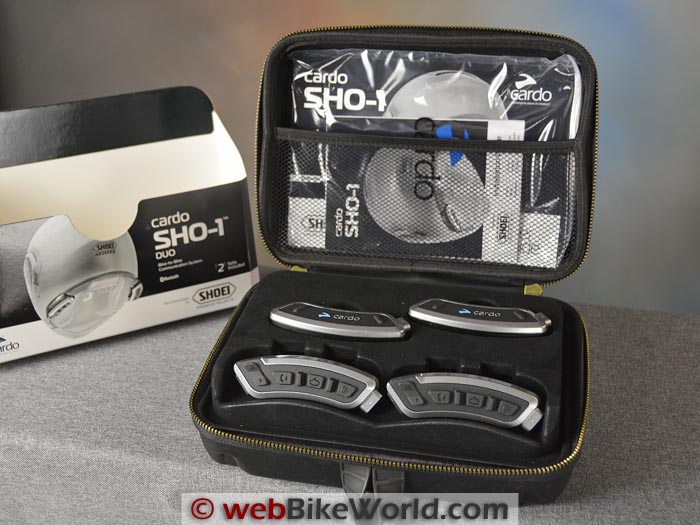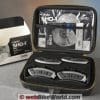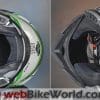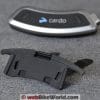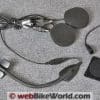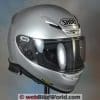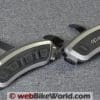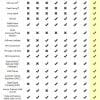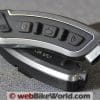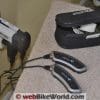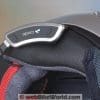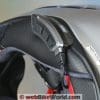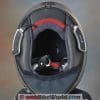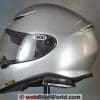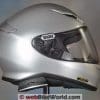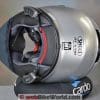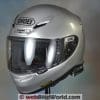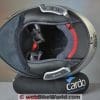The Cardo SHO-1 is a new Cardo motorcycle helmet intercom system designed specifically for Shoei helmets.
The SHO-1 was introduced at the 2013 EICMA show and the details were first announced in this Cardo SHO-1 preview, which was exclusive to webBikeWorld.
The SHO-1 system is functionally similar in many ways to the Cardo Q1/Q3 intercoms (review), recently named the webBikeWorld 2013 Motorcycle Product of the Year.
Cardo has employed a different form factor for the SHO-1 intercom modules, separating the battery and intercom control modules, which are installed on either side of the helmet.
This format directly addresses the requests from many intercom owners for replaceable batteries and the SHO-1 battery module can be quickly and easily swapped out if necessary.
Although with a talk time ranging up to 13 hours and a week’s worth of standby, an extra battery is somewhat redundant.
The SHO-1 system has been tested and approved for several European versions of Shoei helmets, but we discovered a secret: the system will also fit many non-Shoei helmets.
The Cardo SHO-1 intercom system fits very nicely in the Shoei RF-1200 (review), which is the U.S. version of the Shoei NXR sold in Europe.
In fact, the lower profile, clean installation and removable battery module go a long way towards making the SHO-1 the motorcycle intercom system to have for European Shoei owners.
The SHO-1 is a fantastic performer, with many new and updated features and outstanding sound quality through the new “HD” speakers.
We asked Shoei U.S.A. if and when the SHO-1 will be available for the North American market, but they were non-committal at this point. Hopefully, this webBikeWorld review and the response from American Shoei owners will help decide the issue.
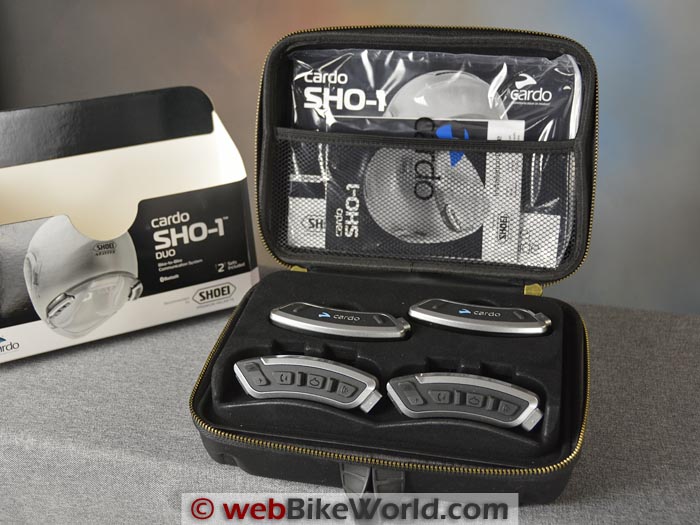

The Cardo SHO-1 Form Factor
The most unique feature of the Cardo SHO-1 system is the separate intercom and battery modules.
The intercom module looks similar to other motorcycle Bluetooth intercoms but the absence of an internal battery in the intercom module gives it a thinner or flatter profile and it fits underneath and to the lower side of the helmet for a much more bespoke and streamlined appearance.
The battery module matches the styling of the intercom module and it even has two raised ribs. But in this case, they act as a sort of bumper when the SHO-1 system is installed and the helmet is placed upright on a table or the ground.
You’ll have to be a little more careful about how you rest the helmet, but with a $300.00+ Shoei helmet, you’re pretty careful anyway, right?
Separating the intercom and battery modules isn’t new and this format has been used before with motorcycle intercom systems to varying degrees of success.
The form factor has its pros and cons but we think the Cardo SHO-1 implementation is the best we’ve seen so far.
The Cardo system just seems like a more elegant solution than the similar dual-module system of the Sena SMH10R (review) because the modules in the Cardo system are more integrated with the Shoei helmets.
In all fairness however, the Sena system was designed to fit multiple brands of helmets with or without a larger bottom shell gasket.
The secret trick we discovered is that the Cardo SHO-1 system will fit other brands of helmets. For example, we grabbed the AGV Horizon (review) off the webBikeWorld Garage Sale shelf and fitted it with the SHO-1 system.
The Horizon has the narrow gasket along the bottom of the shell and the intercom modules were a tight fit, but it works, as you can see in the photos below.
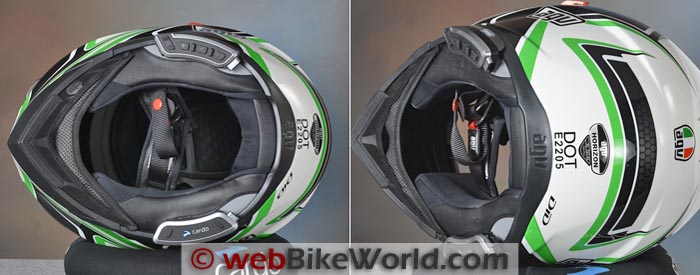


Installing the Cardo SHO-1 in Shoei Helmets
Installing both of the SHO-1 modules, hiding the module connecting wire and the speaker and microphone wires under the liner is definitely a more complicated project than attaching a “normal” single intercom module with boom mic headset on the left side of a helmet.
But it’s a project that any owner should be able to accomplish.
The SHO-1 kit comes with a separate installation guide, printed in 9 languages, that simply but adequately explains how to install the system.
Take your time, read through the instructions a couple of times first and you should be OK.
The process requires a bit more fiddling and messing about with the liner than installing a single-module system, but the end result is a cleaner look due to the way the flatter intercom and battery modules fit into the Shoei helmets.
The clean installation is a direct result of the Shoei and Cardo partnership on developing the SHO-1 system.
Shoei is obviously one of the highest quality helmet manufacturers in business today.
And the high-quality liner and liner attachment snaps that you pay the Shoei premium for which are used in the removable Shoei helmet liners make it easier to remove and replace the liner and cheek pads as you’re installing the intercom bits.
Cheaper helmets usually have cheap “one-time” snaps with loose tolerances, making it difficult to remove and replace the liner parts and get everything realigned.
The design of the Shoei helmet shell and EPS foam crush layer, along with the design of the lower part of the helmet and the gasket and the cheek pads also make for a better-looking SHO-1 fitment in a Shoei helmet.
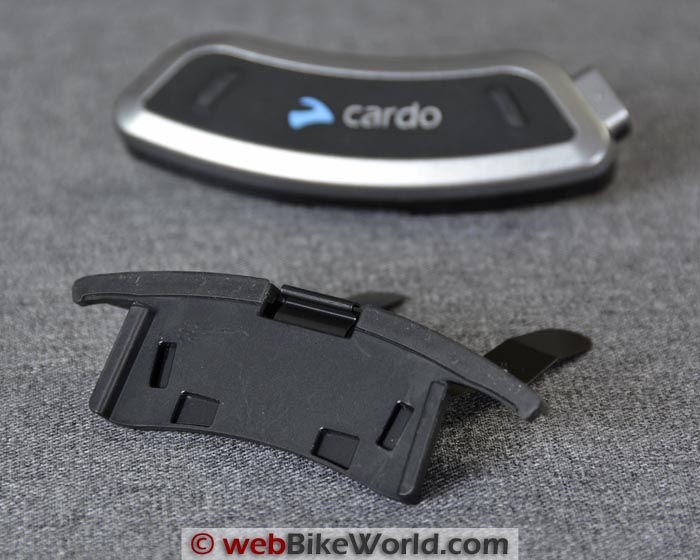


Intercom and Battery Module Installation
The SHO-1 intercom module has two thin built-in plastic tabs that slide into the helmet, between the EPS and helmet liner.
The shorter tab aligns with the center of the visor rotating mechanism on the side of the helmet and this places the longer tab towards the rear.
The longer tab on the intercom module has tiny raised dots for, we assume, better friction as it fits into the helmet.
This tab also contains an embedded Bluetooth antenna, which is key to helping the SHO-1 obtain its long communication range of about 1.6 km, which we confirmed on a relatively flat and open road.
The smaller tab contains a separate antenna for the “Group Signal” function, which allows riders to send an audio signal to up to 8 fellow riders simultaneously. Cardo told us that this entire mechanical solution is patent pending.
The battery module snaps on to a separate holder and the holder has two tabs that also fit between the helmet shell and EPS. The holder allows the battery to be removed for charging or replacement; extra battery packs are available as an optional accessory.
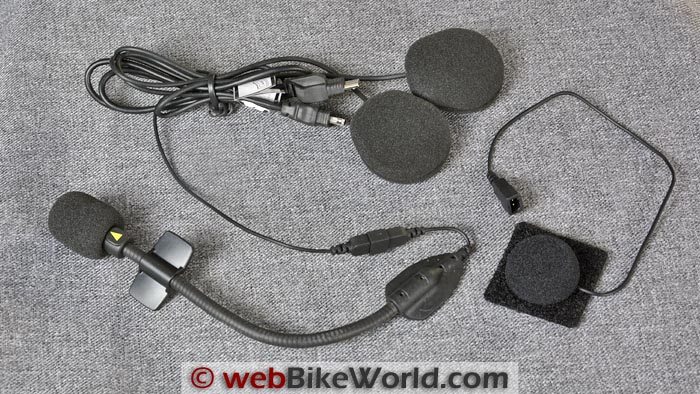


Wiring Installation Notes
Two wire harnesses are included with the SHO-1 Duo two-pack kit. Each wire harness includes wiring for the two HD stereo speakers; the wire that connects the intercom and battery module; and a wire for the mic.
The microphone wire has a connector and the kit comes with a pair of boom mics and a pair of wired “snowball” mics that can be attached to the inside of the chin bar on a full-face helmet if desired.
One caution on using the wired snowball microphone: if the chin bar has an air intake channel, chances are the wind noise will (dramatically) affect the mic performance, so you may have to either move the mic elsewhere on the chin bar or use the boom mic. We prefer boom mics anyway…
The wire that connects the two speakers must be placed above the liner along the top of the helmet. This is why you must have a helmet with a removable liner for the SHO-1 system.
As on the Cardo G9, we think the speaker wire acts as the FM radio antenna, because we noticed FM radio reception differences as we moved the speaker wire around during installation.
Tip: Use a piece of tape to hold the wires to the EPS, but don’t block any vent holes or channels.
We used the high-quality 3M Performance Plus Duct Tape 8979,, which is removable, expensive and works well; we use it in the garage quite often because it’s removable and leaves no residue.
Speaker Installation Notes
The wire that connects the two modules can be hidden under the bottom part of the rear of the helmet liner. The speakers are 10 mm thick, including the covering, so hopefully your helmet will have speaker indents in the ear pockets.
If the helmet fits tight on the side of your head, as Shoei helmets will because of their “Slight Narrow” internal shape (see the wBW Motorcycle Helmet FAQ page) then the speakers may press against your ears, which can be painful.
You may have to remove the lining that Shoei uses in the ear pockets to allow a bit more room and place the speakers in the molded recess in the EPS.
SHO-1 USB Connectors
The intercom module uses a thicker 10-pin mini-USB connector that is surrounded with thicker rubber to make a water-resistant connection when it’s plugged into the recessed USB port in the intercom module.
The battery module uses a smaller (standard) 5-pin mini-USB connector for its water-resistant connection.
By the way, Cardo rates the entire SHO-1 system as “waterproof and dustproof” but we couldn’t find any official IP ratings listed for the set.
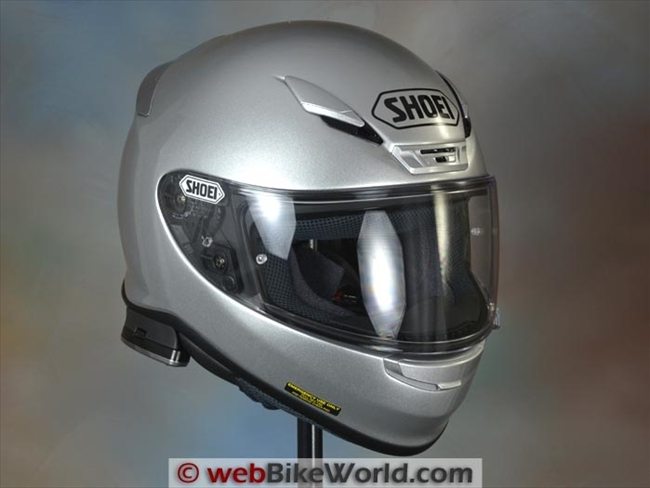


Approved Shoei Helmets for the Cardo SHO-1
Shoei and Cardo have tested and approved several Shoei Europe helmets for SHO-1 fitment, and they include the helmets shown in the following table, along with their corresponding U.S. versions.
As we noted above, we experimented and discovered that the SHO-1 system will fit on some other helmets.
To fit the SHO-1 system, a helmet will need a thin bottom shell gasket and the ability to insert the intercom and battery module tabs between the shell and EPS.
The profile of the shell along the bottom/side should be flat/straight or smooth, although the sharp angle on the side of the RF-1200 works also. And the helmet’s liner and cheek pads must be removable to place the wiring for the SHO-1 system.
|
Cardo SHO-1 Intercom System Shoei Helmet Fitment
|
|
|---|---|
|
Shoei Europe Approved Fitments
|
Corresponding U.S. Helmet Version
|
|
|
Fitment Notes
Shoei and Cardo recommend the SHO-1 for use in European and some Japanese market versions of Shoei helmets only.
Our list of corresponding U.S. Shoei helmets shown above is for reference only and we don’t know whether the SHO-1 will fit the U.S. helmets or not (although we know for sure that the SHO-1 does fit the NXR and RF-1200 because we tried it, as you can see in the photos included in this review).
Note also that Cardo lists the Shoei Multitec as SHO-1 compatible (we didn’t try to fit it) but the Multitec is not listed in the Shoei Europe helmet lineup; it’s apparently a U.S. only helmet.
What About the Shoei GT-Air?
Regarding the popular Shoei GT Air (review), which was named the webBikeWorld 2013 Motorcycle Helmet of the Year, Cardo told us that the SHO-1 will fit.
But a small percentage of the users reported a certain level of discomfort around the ears when mounting and dismounting the helmet with the SHO-1 installed.
For this reason, Cardo doesn’t include the GT Air in the list but if you position the SHO-1 intercom module on the left side and the battery module unit on the right side in a non-symmetric position (one forward and the other one towards the rear), this apparently solves the problem for most GT Air owners.
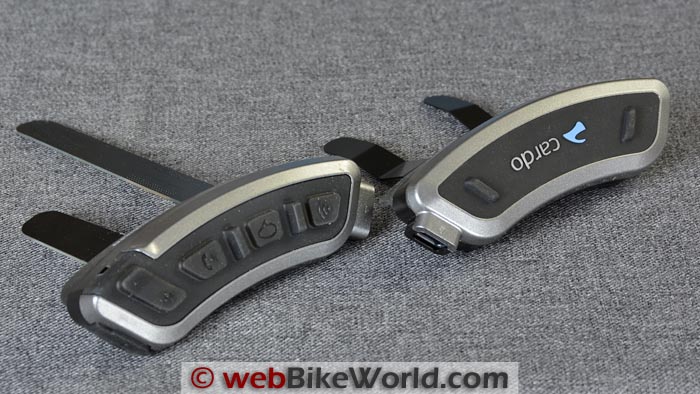


Buttons and Gloves
One of the biggest problems — or should we say “issues” — with a motorcycle intercom is developing the “muscle memory” to remember where the buttons are located and which ones to push when.
The problem is exacerbated when wearing heavy winter gloves and it also depends on individual finger shapes and sensitivity.
The raised rubber-covered buttons on the SHO-1 intercom module (photo above) are what we’d call adequate for the task, but there is something of a compromise between the smaller profile of the SHO-1 intercom module and the available real estate for buttons.
The volume up/down rocker (towards the front when the intercom is helmet-mounted) and the “Music and Mobile” button (the second button back) could use another raised rib in our opinion.
How this might be accomplished with the smaller size of the SHO-1 intercom module is the question…
The raised ribs between the second and third button (the “Voice Command” button) and again between the Voice Command button and the intercom on/off button in the rear help.
Perhaps it would have been better if the on/off button were placed on the side of the intercom module, which would free up real estate to make the remaining buttons larger and even add a third raised rib.
The bottom line here is that the buttons on the SHO-1 could be easier to find and push when wearing heavy winter gloves, as we are in our recent local weather conditions, where if the sun is shining and the roads are clear of ice and salt, we can sneak out for a ride.
Cardo SHO-1 vs. Cardo Family Differences
Besides the obvious form-factor difference, with the separate intercom and battery modules, much of the “guts” (or more accurately, the “brains”) of the Cardo SHO-1 intercom system is similar to the recently introduced Cardo Q1 and Q3 intercoms reviewed by webBikeWorld in July of 2013 (was it really that long ago?) and the Cardo Scala Rider G9 intercom (review).
So we won’t get into a lot of that same detail in this review; rather, we’ll focus on the differences and improvements that makes the SHO-1 intercom system unique.
Cardo now makes 8 different motorcycle intercom systems (14 if you count the Multiset/Pro, Teamset, Powerset and DUO dual kits), which may seem a bit confusing. But the feature differences are easily explained in this matrix from the Cardo website:
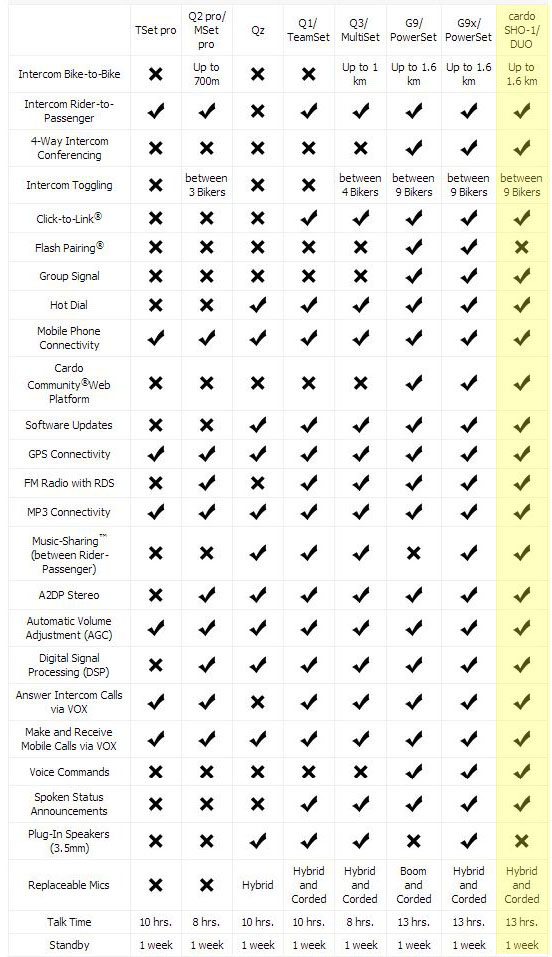

The basic intercom functions (talk, listen, connect with one or more other intercoms, connect with devices) are similar and the SHO-1 is most closely related to the Cardo G9x system, which we have not reviewed.
But the differences between the Cardo Scala Rider G9 intercom (review) that we did review and the G9x amount to the flash pairing feature of the G9x that frankly isn’t too important (and probably sees minimal use) and the removable speakers of the G9x.
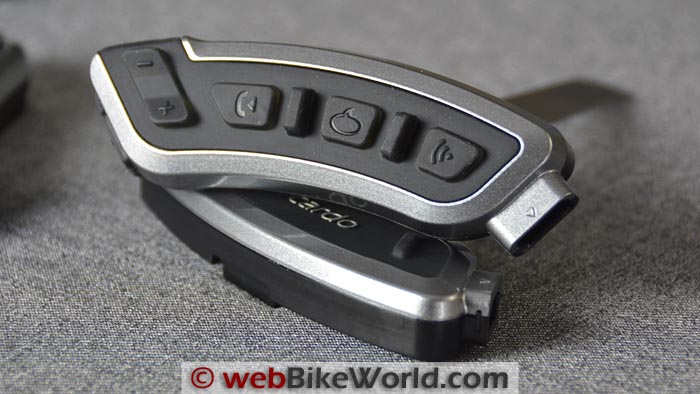


Cardo SHO-1 “HD” Speakers
Besides the new, sleek form factor, the SHO-1 feature that most impressed us right out of the box is the quality of the speakers. They are, in a word, fantastic.
Burn and I think they’re the best-sounding speakers we’ve ever experienced in a motorcycle intercom and rival the better over-the-ear, non-intercom stereo speakers.
In fact, the quality is so good that if I could, I’d rather listen to music through the SHO-1 speakers than any earbud system I have tried, up to and including the Bose Quiet Comfort 20 (review), theME Electronics M6 Earbuds (review) and others.
The quality is enhanced by the thick and plush insulating padding of Shoei helmets and the volume, although it could always be louder for some riders, is excellent.
The speakers in the SHO-1 system aren’t removable, but they are connected as part of the microphone module that does connect to the intercom module on the left side of the helmet via a 10-pin mini-USB connector. But there’s no reason to remove or replace them, because the apparently updated speakers in the SHO-1 are now listed as “HD”.
Despite the quality improvements, the speakers also seem smaller and they’re covered with a new, very soft type of squishy fabric that is a real improvement over the typical foam (or no) coverings on other motorcycle intercom speakers.
A slight speaker recess has appeared in the ear pockets of recent Shoei helmets, apparently presaging the introduction of the SHO-1, which was developed with Shoei input and approval.
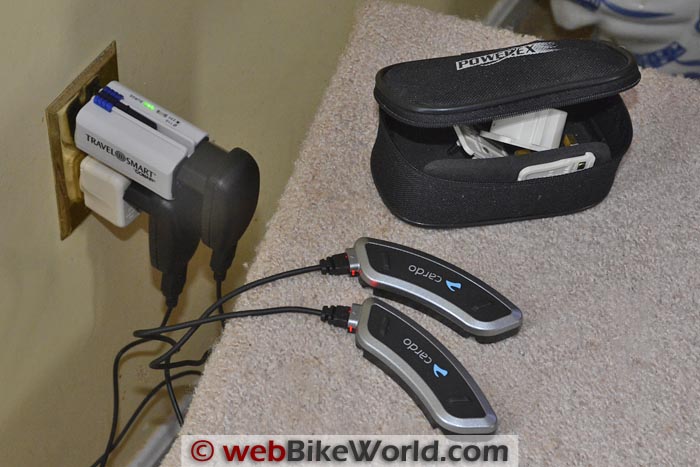


Cardo SHO-1 Features
The SHO-1 is one of the most advanced intercom systems Cardo has produced, with all the latest updates, features and functions.
As we mentioned earlier, many of the features and the performance is similar to the Cardo Scala Rider G9 intercom, so we decided to focus on the unique technical aspects of the SHO-1 rather than repeat a lot of information that we’ve already covered on how the intercom works.
Here’s a bulleted list of some of the SHO-1 features that we confirmed during our evaluation over the last couple of weeks:
- Up to 1.6 km (~1.0 mile) range, depending on local terrain.
- 4-Way full duplex intercom conferencing.
- Cardo says the SHO-1 will connect with a group of up to 9 other riders (you plus 8 more). We didn’t try this feature.
- Voice commands allow hands-free operation. If the system is in standby mode, a loud “OK” or “HEY!” or similar will wake up the system, beep and you can direct it to make a call, turn on the FM radio, etc.
- Click-to-Link intercom for spontaneous conversation with other riders nearby. We didn’t try this.
- The SHO-1 is compatible with the Cardo Community for device customization, software updates and more.
- The SHO-1 also includes the new “Music Sharing” feature, which allows bot the rider and passenger to listen to the same music stream (via A2DP).
- Group Signal sends audio signals to up to 8 fellow riders simultaneously. Didn’t try it but seems interesting for riding in groups, where you can signal danger in the road or a burrito stop.
- Spoken status announcements are clear and understandable and available in several languages.
- The speaker volume will adjust depending on ambient noise levels.
- The Automatic Gain Control and VOX can be customized (didn’t try it).
- The volume levels are saved when you switch among features.
- The SHO-1 system will allow you to pair with up to two mobile phones simultaneously. Not sure why you’d want to do this (and we didn’t try it).
- A2DP/AVRCP profile for wireless streaming stereo from smartphones.
- Conference calling mode to share a phone call with the rider and passenger. Don’t do this while riding, please!
- FM radio has up to 6 presets with auto scan. The FM radio works very well in our units and it will mute when a call comes in or during GPS status announcements.
- Bluetooth connection to other Bluetooth-enabled devices, like smartphones, music players, etc. Can also connect auxiliary devices via input cable.
As you can see, the Cardo SHO-1 system is loaded with features, and the list above is far from complete — there are many features that we either didn’t list or missed.
Like any of the high-end motorcycle intercom systems, it will take some time to study and understand how to use the SHO-1 to its best advantage and you will definitely want to familiarized yourself and your riding companions before starting out for a ride.
To help, here’s a “Quick Guide” in .pdf format that you can print or save. Other resources include the SHO-1 owner’s manuals in multiple languages and the tabs on that page list the specifications, user guides and more.
Conclusion
The Cardo SHO-1 is the latest and, some might say, greatest new Cardo motorcycle intercom system yet.
While perhaps more complicated to install and use due to its rich feature set, the performance and sound quality are among the best in the business, making it our new favorite Cardo intercom system.
Burn and I use the basic functionality of intercoms quite frequently as we need to communicate when out on a ride evaluating equipment. But we rarely dip into the more complex features and I almost never make or take a phone call while on the road.
But that doesn’t matter — while the SHO-1 system may be slight overkill for our use, it is also a nearly plug-and-play system if all you want is high-quality communication between riders or between a rider and passenger.
The voice sound quality, music streaming and GPS instructions provided excellent performance during our evaluation and the FM radio works very nicely too, with the stronger stations providing more excellent sound.
Bluetooth music streaming from a smartphone is also a joy and to our ears, the sound quality from the new HD speakers is amazing.
We have a feeling that Cardo will be selling a lot of these to both Shoei and non-Shoei owners.
The smaller, sleeker form factor really works while looking much less cumbersome than most accessory helmet intercom systems, up to and including the Cardo G9 and more recent Q1/Q3 systems. So we think that many owners will opt for the SHO-1 system instead.
I’m sure Cardo won’t mind, as long as you’re staying in the Cardo family!
Owner Comments and Feedback
See details on submitting comments.
From “J.D.” (June 2014): “I pulled the trigger on a SHO-1 system for my Shoei GT-Air last week and first ride went well.
During the installation process I was able to leave the ear covers that come with the helmet installed, but it does push the foam out slightly as expected and consequently makes putting on the helmet a little more difficult.
The tops of my ears tend to get scrunched down during helmet donning and it takes a bit of effort to get them lying flat and avoid hot spots. I may pull out the stock Shoei ear covers but I’m a little concerned with increased road noise.
For the North America folks, you can get these from a variety of vendors in Europe. I got my from Motard Inn, and it showed up on my doorstep via DHL from Spain within 5 days.
I have a Gamin 590 to integrate too and I see the biggest challenge is to manage all the functionality effectively (nav voice prompts, telephone, intercom, music, etc.).”
From “A.H.” (May 2014): “After just reviewing many of the leading brands and latest models of motorcycle intercom, Midland, Sena, Scala and Inter phone, I wanted to share my experience with the SHO-1, simple as there are so few reviews from actual buyers of the product.
I eventually persuaded various retailers to let me try the different devices in store where I assessed them for practicality and functionality, ease of installation, weight, robustness, ease of pairing, sound quality.
I decided to purchase the SHO-1 for several reasons; the build quality is first class, yes it’s designed specificity for certain Shoei helmets (I already had the Shoei Neotec (review)) but according to many it will fit other helmets too, although I have no experience of this.
It fits the Neotec like a dream; the SHO-1 is super light, super sleek and extremely unobtrusive! From my testing no other model comes close in this respect.
Fitting took me 40 minutes, but I’m a bit of a self-confessed perfectionist and I like all the wires ultra neat.
The SHO-1 is very simple to use, through logical sequencing of the easy to locate and use buttons, the voice prompts are a very neat and intuitive feature as is the hot button.
I particularly like the separate battery as I purchased a spare which I will keep fully charged and in a pannier just in case I forget to charge the main unit one evening.
Also on most other units when the battery dies, as they do, it’s a case of throwing the unit away and buying new again, so there in the SHO-1 there is a long-term cost saving too!
Lastly, but of most significance is the sound quality; you really have to listen to these speakers in helmet to believe the incredible clarity and quality, it is seriously better than my Bose headphones! Be it music or radio the sound quality is mind blowing!!!!
Yes the SHO-1 does not come cheap at £299 for a single and £499 for the twin set but for me it’s money very well spent. I can only recommend this product and score it 10/10.”
From “J.C.” (May 2014): “Plus 1 on TJ’s comment (below). I have been holding out on purchasing an in helmet comm device, in hopes that Cardo would release this in North America. Now that I read his (TJ’s) comment, I’ve decided to go with a different(non-Cardo) device. More or less out of principle. Cardo says (the heck with) Americans, I say “(the heck with) Cardo!”
From “T.J.” (April 2014): “I really enjoyed your review of the Cardo Systems SHO-1 Bluetooth headset. The device seems to be a hot ticket.
I, however, cannot understand what Cardo is doing by not offering the device to North America.
Even making attempts to purchase from their international website results in redirects to their North American website with “nothing found’ results.
I have asked Cardo directly why this is so, hoping that I would receive a logical explanation regarding marketing, something I would accept, but instead received unsatisfying responses akin to “it’s just not going to happen”.
As an avid motorcyclist, and Shoei helmet owner since 1977, I suggest that this type of response is “just not good enough”.
I note that you indicated in your review that in writing a comment regarding its status of availability to North Americans might prompt an interest in them to provide these devices to the N. American market, but I can say that this isn’t going to happen without a good hard push.
Perhaps if there is to be another review of sorts offered to your readership, you might include Shoei and the partnership they entered into with Cardo and perhaps why Shoei has remained quiet regarding these Cardo market omissions to North American supporters of both Shoei and Cardo products.
It might be worth noting that Cardo also makes a similarly fitted comm for SCHUBERTH. The device is, after all, something Cardo themselves heralded as the best device out there on their websites, for the whole world to see. It’s bizarre this is not offered everywhere and this is worth explaining.”
Editor’s Reply: Note that Shoei is also involved in the decision and they have not yet made a commitment to offer the SHO-1 system in the U.S.A.


